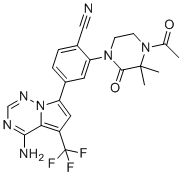
PI3Kδ inhibitor 52
CAS No. 1911564-39-0
PI3Kδ inhibitor 52 ( —— )
Catalog No. M12995 CAS No. 1911564-39-0
A potent, selective, and efficacious PI3Kδ inhibitor with IC50 of 1.7 nM.
Purity : >98% (HPLC)
 COA
COA
 Datasheet
Datasheet
 HNMR
HNMR
 HPLC
HPLC
 MSDS
MSDS
 Handing Instructions
Handing Instructions
| Size | Price / USD | Stock | Quantity |
| 5MG | 222 | Get Quote |


|
| 10MG | 357 | Get Quote |


|
| 25MG | 597 | Get Quote |


|
| 50MG | 851 | Get Quote |


|
| 100MG | 1152 | Get Quote |


|
| 200MG | Get Quote | Get Quote |


|
| 500MG | Get Quote | Get Quote |


|
| 1G | Get Quote | Get Quote |


|
Biological Information
-
Product NamePI3Kδ inhibitor 52
-
NoteResearch use only, not for human use.
-
Brief DescriptionA potent, selective, and efficacious PI3Kδ inhibitor with IC50 of 1.7 nM.
-
DescriptionA potent, selective, and efficacious PI3Kδ inhibitor with IC50 of 1.7 nM, >100-fold selectivitity over PI3Kγ/α/β; shows potent activity in mouse arthritis models.
-
Synonyms——
-
PathwayPI3K/Akt/mTOR signaling
-
TargetPI3K
-
RecptorPI3K
-
Research AreaInflammation/Immunology
-
Indication——
Chemical Information
-
CAS Number1911564-39-0
-
Formula Weight471.44
-
Molecular FormulaC22H20F3N7O2
-
Purity>98% (HPLC)
-
Solubility——
-
SMILESCC(=O)N1CCN(C(=O)C1(C)C)C2=C(C=CC(=C2)C3=CC(=C4N3N=CN=C4N)C(F)(F)F)C#N
-
Chemical Name2-(4-acetyl-3,3-dimethyl-2-oxopiperazin-1-yl)-4-(4-amino-5-(trifluoromethyl)pyrrolo[2,1-f][1,2,4]triazin-7-yl)benzonitrile
Shipping & Storage Information
-
Storage(-20℃)
-
ShippingWith Ice Pack
-
Stability≥ 2 years
Reference
1. Liu Q, et al. J Med Chem. 2017 Jun 22;60(12):5193-5208.
molnova catalog


related products
-
TG6-10-1
TG6-10-1 is an EP2 antagonist.
-
Autophinib
Autophinib is a novel, potent autophagy inhibitor that inhibits autophagy induced by starvation (IC50=90 nM) or rapamycin (IC50=40 nM) by targeting the lipid kinase VPS34 (IC50=19 nM).
-
AS2541019
AS2541019 is a novel potent, selective, orally active PI3Kδ inhibitor with IC50 of 20.1 nM.



 Cart
Cart
 sales@molnova.com
sales@molnova.com


